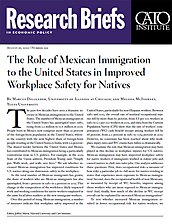The past few decades have seen a dramatic increase in Mexican immigration to the United States. The number of Mexican immigrants in the United States has quintupled since 1980, rising from 2.2 million to 11.6 million in 2015. People born in Mexico now comprise more than 25 percent of the foreign-born population in the United States, whereas the country with the next highest share of foreign-born people residing in the United States is India, with 5.9 percent. The shared border between the United States and Mexico has contributed to Mexican immigration being a particularly contentious issue in U.S. politics. For example, in the 2019 State of the Union address, President Trump said, “Simply put: Walls work, and walls save lives.” We ask whether increased Mexican immigration has improved conditions for U.S. natives along one dimension: safety in the workplace.
As the total number of Mexican immigrants has grown, the share of workers who are Mexican immigrants has also quintupled, from 1 percent in 1980 to 5 percent in 2015. This change in the composition of the workforce likely impacted work and working conditions for native workers employed in the same local labor markets as the new immigrant workers. Over this period of rising Mexican immigration, a number of measures indicate that workplace safety improved in the United States, particularly for non-Hispanic workers. Between 1980 and 2015, the overall rate of nonfatal occupational injuries fell by more than 60 percent, from 8.8 per 100 workers in 1980 to 3.0 per 100 workers in 2015, and data from the Current Population Survey (CPS) show that the rate of workers’ compensation (WC) cash benefit receipt among workers fell by 68 percent, from 2.0 percent in 1980 to 0.64 percent in 2015. However, no consensus has been reached about why workplace injury rates and WC claims have fallen so dramatically.
We examine the role that Mexican immigration may have played in this decline in workplace injuries for U.S. natives. Mexican immigration may have improved workplace safety for native workers if immigrants worked in riskier jobs and caused natives to shift into safer jobs. Our analysis addresses three questions. First, does occupational risk—a measure of how risky a particular job is—fall more for natives residing in states that experience more exposure to Mexican immigration? Second, does the occupational health of non-Mexicans, as measured by receipt of WC benefits, improve among those workers who are more exposed to Mexican immigration? And, finally, how much of the decline in WC receipt overall can be explained by increased Mexican immigration?
To test whether increased Mexican immigration resulted in lower occupational risk for native workers, we create a measure of occupational risk using O*NET’s information on physical work conditions that we benchmark to the job’s occupational risk in 2010. This allows us to analyze changes in workers’ job risk over time arising from changes in occupation, not improvements in working conditions within a job. Our measure of occupational risk is the occupation’s percentile rank in the 2010 distribution of physical conditions—a higher percentile corresponds to an occupation having more physical demands and greater risk of injury. We quantify immigration from Mexico at the state level using the 1980, 1990, and 2000 Decennial Censuses and the 2001–2015 American Community Surveys. We examine whether natives residing in states that experienced larger increases in Mexican immigration experienced greater reductions in occupational risk, as measured by the physical requirements of the jobs described by O*NET.
Our results point to Mexican immigration leading to meaningful improvements in workplace safety for native and non-Mexican workers and fewer WC claims overall. We find that increased Mexican immigration has led to natives working in jobs with lower measures of occupational risk, on average. In fact, Mexican immigration can explain 26 percent of the improvements in occupational risk among natives between 1980 and 2015, and these effects are concentrated among native workers with medium levels of education—that is, a high school degree or some college.
We turn to the CPS to measure the effect of Mexican immigration on natives’ occupational health. Our measure of occupational health is a binary measure of whether the non-Mexican worker reports receiving WC cash benefits within the past year. A worker who has been injured on the job and has missed several days of work is eligible to receive cash benefits from WC, so this measure allows for studying the effect of Mexican immigration on relatively major occupational health incidents. The second key finding from our analysis is that Mexican immigration explains approximately 17 percent of the reduction in WC claims among non-Mexican males between 1980 and 2015.
We then assess the role of Mexican immigration on WC claims overall—that is, with Mexicans included in the sample. Mexican immigration could lower overall WC claim rates if immigrants are healthier than natives or less likely to file for WC if injured. We find that increased Mexican immigration indeed led to a reduction in WC claims overall, accounting for approximately 11 percent of the decline in WC receipt among male workers during this period. This decline in WC claims is one of the major occupational health trends that has occurred in recent decades, and no consensus has been reached regarding its cause. In addition, employer WC costs are high in the United States—totaling nearly $95 billion in 2015—so understanding factors that explain the downward trend in WC receipt has implications for employer WC costs, and we provide the first evidence that Mexican immigration had an impact on employer WC costs. Without Mexican immigration, employer costs for WC would have been higher.
NOTE:
This research brief is based on Marcus Dillender and Melissa McInerney, “The Role of Mexican Immigration to the United States in Improved Workplace Safety for Natives from 1980 to 2015,” Journal of Health Economics 70 (2020), https://www.sciencedirect.com/science/article/abs/pii/S0167629619303005.
About the Authors

This work is licensed under a Creative Commons Attribution-NonCommercial-ShareAlike 4.0 International License.
